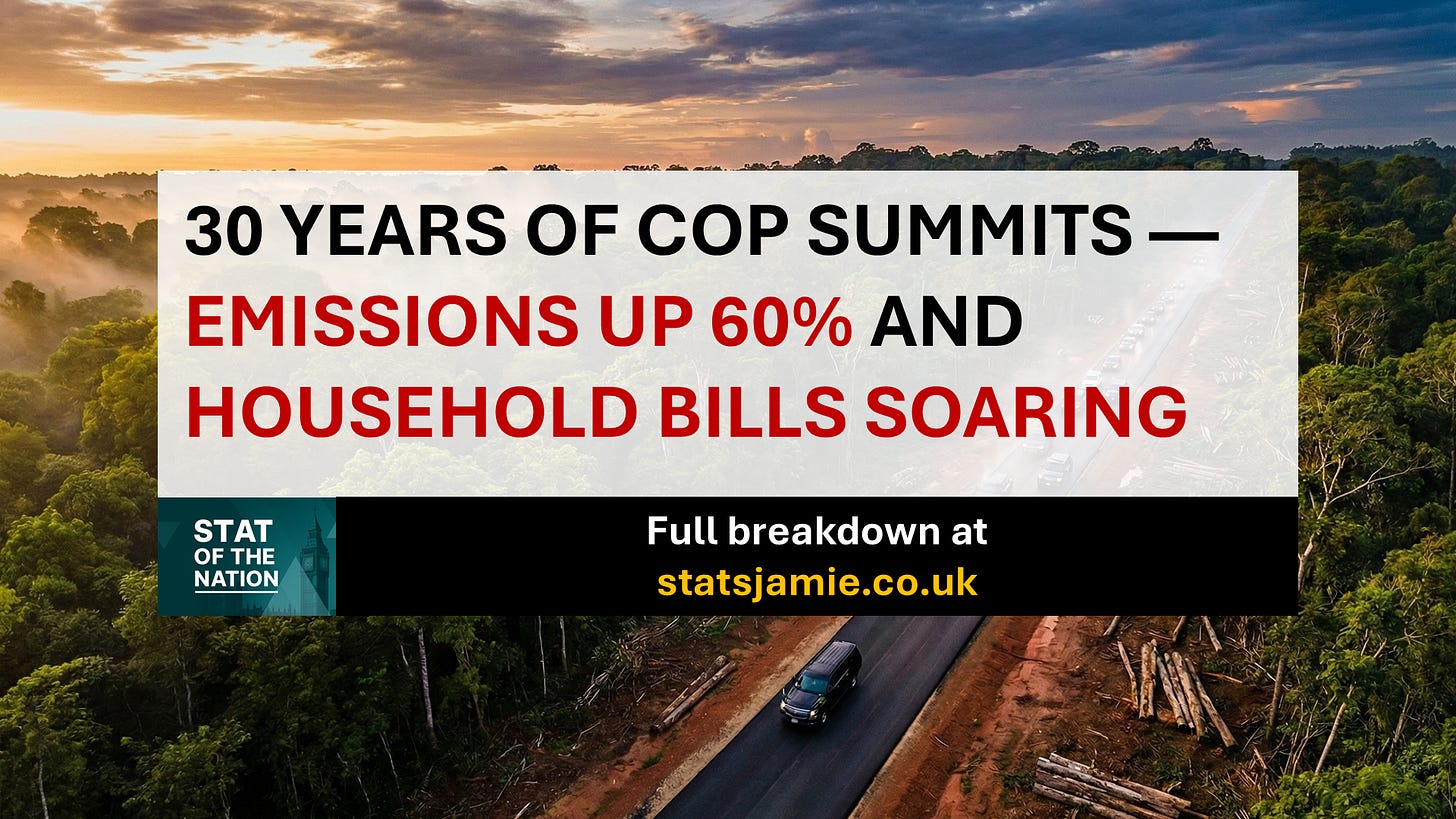30 Years Of COP Summits - Emissions Up 60% And Household Bills Soaring
The Amazon was carved up to host COP30, but global emissions and UK energy bills only go one way
COP30 has just finished in Belém, deep in the Amazon — and the contradictions couldn’t be clearer.
Around 56,000 registered delegates — politicians, officials, NGOs, lobbyists, corporate reps and activists — flew into the rainforest for two weeks of climate meetings.
To host them, Brazil fast-tracked a 13km highway through a protected area, cutting into rainforest so VIPs could shuttle between venues in air-conditioned convoys.
And here’s the key point: the purpose of COP is to reduce global CO₂ emissions. Whether that’s necessary or not, we can park that debate. The data is simple: after 30 years of COP, global emissions are up sharply.
1995 (COP1): ~23.5 billion tonnes
Today: ~37–38 billion tonnes
An increase of roughly 60%
After all the speeches, declarations, midnight sessions and “historic” announcements, nothing major changed. COP remains a massive, carbon-intensive talking shop — while global CO₂ rises regardless.
🌴 The “Amazon COP” Built by Cutting Down the Amazon
This summit was sold as the moment the world would “stand with the rainforest”.
In reality:
A 13km highway was cut through the Amazon rainforest specifically for COP30
Protected zones were cleared for compounds, logistics and motorcades
Locals and Indigenous groups protested, calling it “green colonialism”
The world’s elites flew into the rainforest to discuss protecting the rainforest, while physically damaging it to make the summit possible.
You couldn’t design a more fitting metaphor for modern climate politics. Belém overflowed. Cruise ships were brought in as floating hotels. The world’s most carbon-intensive conference is the conference about carbon.
This is the climate industry in 2025: a global touring operation that grows every year — while the global emissions it claims to address continue to rise.
🌎 Europe’s Emissions Trick — Offshoring Disguised as Climate Progress
The long-term rise in global CO₂ is driven almost entirely by Asia’s industrial growth.
Africa and South America grow from low starting points. North America is flat. Europe appears to fall — but that’s mainly a statistical illusion.
Which brings us to the next point. European leaders boast that their emissions are falling. On paper, they are. In reality, Europe shut down its own industry and now imports the same high-carbon goods from overseas. The emissions didn’t go away — they were outsourced to Asia.
Factories close in Britain, Germany and France. Production moves to India and Southeast Asia, where steel, plastics, cement and chemicals are overwhelmingly coal-powered.
Europe then buys the same products back and claims climate “progress”. It’s not decarbonisation — it’s deindustrialisation dressed up as environmental virtue.
🔨 The UK Steel Industry: The Perfect Example
The UK once had a thriving steel industry. Now, blast furnaces are shutting, and communities built on industry are left behind.
Why? Because Net Zero levies and high energy costs make it far cheaper to import steel from India, Vietnam and Indonesia than to produce it in Britain.
So we shut our plants and import foreign steel made with coal.
The result?
Europe’s emissions appear to fall
Global emissions don’t
British workers lose their jobs
India and Southeast Asia grow their steel industries
The UK becomes dependent on imports for its own infrastructure
That’s the climate maths no minister wants to talk about.
💸 Billions Spent. Zero Return.
In 30 years, COP has grown into:
A sprawling UN climate bureaucracy
Millions spent on delegations
Hundreds of millions spent on hosting
Endless side-events, panels and workshops
A parallel economy of NGOs, consultants and lobbyists
And yet:
Global emissions rise
Fossil-fuel use grows
“Breakthrough agreements” change nothing
It is a process, not an outcome.
🇬🇧 The UK’s Position: High Costs, No Impact
As delegates fly home from Belém, the UK prepares for its Budget — facing some of the highest energy prices in the developed world.
We have Net Zero levies baked into bills and carbon pricing that pushes industry offshore. This leads to manufacturing contraction and investment leaving the country, resulting in jobs disappearing across energy-intensive sectors.
Britain’s share of global emissions is tiny. Even eliminating it wouldn’t move the global chart — but it would damage Britain’s economy dramatically.
This isn’t a climate strategy. It’s economic self-harm that benefits nobody except foreign competitors.
🧩 Final Verdict: A Carbon-Intensive Ritual Detached from Reality
Climate has always changed and always will.
But the politics built around CO₂ has become:
Symbolic
Expensive
Performative
Economically damaging
Increasingly disconnected from actual global trends
COP30 was supposed to be the “Amazon COP”. Instead, it showcased everything wrong with the process:
Rainforest cleared
Tens of thousands flown in
No new commitments
Global emissions are still rising
After three decades, the truth is unavoidable:
COP doesn’t cut emissions — it just cuts into your wallet, your industry and your jobs.
✍️ Jamie Jenkins
Stats Jamie | Stats, Facts & Opinions
📢 Call to Action
If this helped cut through the noise, share it and subscribe free — get the stats before the spin, straight to your inbox (no algorithms).
📚 If you found this useful, you might also want to read:
📲 Follow me here for more daily updates:



